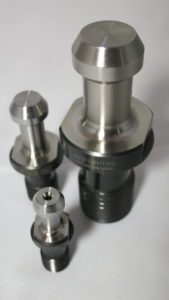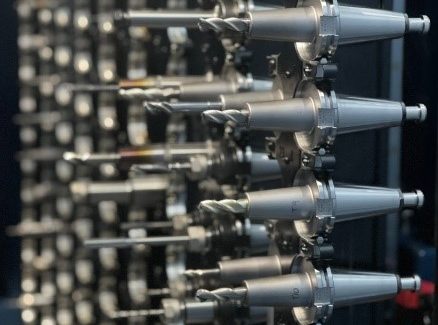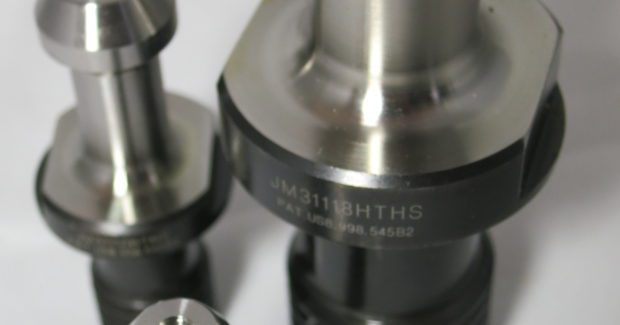Flying S Inc. Improves Accuracy and Reduces Retention Knob Failures
Company utilizes JM Performance Products’ High Torque retention knobs, which eliminate the toolholder expansion responsible for costly CNC milling and boring issues.
Posted: September 27, 2022

More than most industries, aerospace component manufacturing machines a lot of exotic alloys and hard metals like titanium. A byproduct of utilizing these materials is that more pressure is put on the machines, spindles, and retention knobs. The end result is that the tools must be changed out more frequently as they dull or break. The cost of tool replacement, not to mention loss of production time due to frequent changeover, can escalate costs as well−often to dizzying levels.
Recently, Flying S, Inc. (Palestine, IL), a high-quality parts aerospace/aviation industry focused engineering company since 2001, continued its expansion to more palletized five-axis machining center technology to handle the high-volume production precision machining of complex, tight-tolerance parts out of titanium, stainless steel, and other difficult to machine materials. Notably, as the five-axis parts they made for unmanned military and civilian aircraft, along with spacecraft, became more complicated, it became clear that greater machine capability was needed to achieve reliable, unattended operation.
According to Manufacturing Engineer Peter Bowman, “Many of our space flight fittings require tight-tolerance features. Our lack of reliable positional accuracy and repeatability due to thermal growth, machine positioning or other variables, really took a toll on our efforts to consistently make a good First Part, and subsequent parts after that.”
With new five-axis CNC machining centers in place, including state-of-the-art models from Matsuura USA (St. Paul, MN), and Brother Industries, Ltd. (Nagoya, Japan), significantly higher torque and drawbar pressure was being exerted on their standard, low cost retention knobs causing issues with the interface between the toolholder and spindle. Consistently, standard retention knobs were coming loose as dimpling/grooving wear issues repeatedly appeared on the face of the knobs−thus requiring replacement on a regular basis. Whereas machining is about eliminating variables, Flying S actively sought out a solution to resolve their retention knob issues. During a visit to IMTS (International Manufacturing Technology Show, Chicago, IL), Bowman witnessed an expanding taper demonstration by JM Performance Products, Inc. (JMPP: Fairport Harbor, OH), which featured their patented High Torque® retention knobs. Uniquely, the knobs were designed and engineered to eliminate the toolholder expansion responsible for costly and ongoing CNC milling and boring issues.
A leading manufacturing innovator of CNC mill spindle optimization products since 2009, JMPP’s retention knobs feature a relief beneath the precision pilot that forces the threads of the knob deeper into the threaded bore of the toolholder–where a thicker cross-section of material resists the expansion and deformation.
With their multi-axis and unattended operations expansion commitment in full force, Flying S set out to standardize their entire line of CNC machines with JMPP’s retention knobs, in order to overcome catastrophic failure as a result of metal fatigue and other high load force related issues associated with difficult to machine materials and long tooling.
MULTI-AXIS / MULTI-ISSUE VARIABLES:
Today’s CNC mills, like Flying S’s multi-axis machining centers, are designed to operate with greater draw bar pressure, faster tool changes, higher feed rates, and greater depths of cuts, which places more demand on retention knobs in V-Flange tooling than ever before. Flying S was able to address the following key issues via JMPP’s retention knobs.
Titanium Challenge: Superalloys / exotic materials such as stainless steel, aluminum, and titanium are on the rise for component manufacturing in vital growth industries such as aerospace, medical, and automotive.
Considering that high speeds typically in excess of 20,000 RPMs are often required, a unique set of production machining challenges ensue. Notably, vibration and chatter can occur at these rates of speed, leading to poor surface finishes that require secondary bench operations, or result in critical damage to expensive workpieces.
Stability is an essential factor for improving milling performance on demanding materials like titanium–as the entire machining process has to be considered. Any one element could impede the overall process’s effectiveness as the tool, toolholder, spindle, column, ways, table, fixturing, and workpiece are all part of the interconnected ‘machining circle’ that requires stability to achieve optimal results.Retention knobs are the critical connection between your machine tool and the tool holder, and they are the only thing holding a steep taper tool holder in the machine’s spindle. However, often times retention knobs are overlooked by many shops, with a greater focus placed on having a high-quality machine tool, top of the line tool holders and the latest high performance carbide tooling. Then, ironically, they will break the loop by using economy retention knobs.
Notably, they go through thousands of tool changes which means they are subjected to the very high pull forces from the spindle’s drawbar. Excessive torque tends to swell the metal around the retention knob, distorting the toolholder and creating a less-than-perfect fit between it and the spindle taper. Additionally, toolholder expansion caused by standard retention knob installation can reduce the toolholder to spindle contact by 70% or more. It’s no surprise that many machine tool builders specify the use of high-quality retention knobs for best performance.
High Torque Solution:
Yet, just having an expensive retention knob does not mean better performance. JMPP redesigned the standard retention knob into its patented High Torque retention knob which uses the lowest available threads in the toolholder. The pilot portion beneath the knob flange above the threads stabilizes the knob in the toolholder. The High Torque design includes a precision ground pilot, that ensures the perfect alignment of the knob in the holder during installation.
JMPP also manufactures all 30 and 40 taper retention knobs, including the patented High Torque knobs, from AISI 9310H material–offering 40% more tensile strength, instead of the traditional 8620H material.
Editor’s Note: The following is an excerpt from a paper on Flying S’s experiences in improving accuracy and reducing retention knob failure using JM Performance Products’ high torque retention knobs.
To read the complete paper on Flying S’s experiences, click here
Subscribe to learn the latest in manufacturing.

















